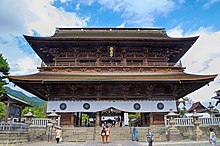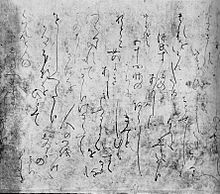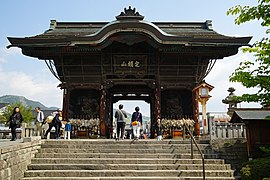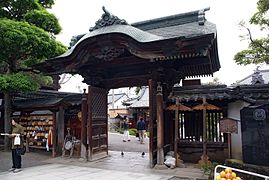Zenko-ji
The Zenkō-ji ( Japanese 善光寺 ), also Shinshū Zenkō-ji ( 信州善光寺 ) to distinguish it from others of the same temples, is the temple of Jōdo direction of Buddhism in the Japanese Nagano in Nagano Prefecture (formerly Shinshū ). - Zenkō-ji has historical significance as the scene of the clashes between Uesugi Kenshin and Takeda Shingen in the 16th century, when it served as the basis for Kenshin.
history
The temple was built under the rule of Emperor Kimmei for the worship of a Buddha trinity ( 一 光 三尊 阿 弥陀 如 来 様 Ikkō sanzon Amida Nyorai -sama ), who, according to the temple's documents, came from China to Japan via Korea in 552 . The temple was lost due to the persecution of the Buddha followers under the Mononobe until it was given its current location in 645 with the help of Honda Zenkō ( 本田 善 光 ). In the Kamakura period (1192-1333), followers of Zenkō-ji built many temples across the country, either under the same name or as "New Zenkō-ji" ( 新 善 光寺 Shin-Zenkō-ji )
In the Sengoku period , the Zenkō-ji got into the dispute between Takeda Shingen and Uesugi Kenshin. In 1555, Shingen therefore transferred the temple treasures to Kofu , for which a Zenko-ji was built there. Then Toyotomi Hideyoshi's help could be moved back shortly before his death in 1598. - The Tokugawa supported the temple as ( 位 牌 所 Ihaisho ), which was then ravaged by fires. Donations were collected all over the country and in 1707 the current main hall was inaugurated. - Originally there were quarters for the pilgrims south of the temple, a typical Monzen ( 門前 ), that is, a "in front of the (temple) gate" settlement. It was not until 1897 that this town received the rank of city.
The attachment
(In the following, national treasures are marked with ⦿, important cultural assets of Japan with ◎.)
The first gate, the Niō-mon ( 仁王 門 ), named after the two wooden temple guards ( Niō ) who are on the right and left in the gate housing, is located far in front of today's temple grounds on the access road leading to the north . It dates from 1752 in this form, but burned down twice. The current gate construction dates from 1918, but is designed in the classic style as Hira- Karamon .
After almost 200 m you come to the soaring main gate ( 山門Sammon ; ◎) in the middle of the temple grounds. It is built as a large rōmon and was completed in 1750. The front is 16.88 m wide, 6.75 m deep and 15 m high, with the roof width being 22.9 m. It is built in a mixed style from “Japanese” and “Chinese” parts. The writing on the board above the passage with the name of the temple comes from the 9th prince head of the Rinnō-ji , i.e. from the time around 1800. This gate is also protected by the two wooden temple guards.
The current main hall ( 金堂 Kondō ; ⦿) was completed in 1707. It is designed in the so-called Shumoku style ( 撞 木造 り -zukuri ), that is, the rear part of the building connects at right angles so that the ridge has a T-shape. The hall extends unusually far, namely 53.65 m to the rear, is 23.85 m wide and 26.06 m high. This makes the main hall one of the largest in Japan. The hall was built by the builder of Bakufu Kōra Muneyoshi ( 甲 良 宗 賀 ). Inside, it is divided into the three hall areas Gejin ( 外 陣 ; A), Naijin ( 内 陣 ; B) and Nainaijin ( 内 々 陣 ; C).
In the front area is the tsumado (erhöht 戸 ), on which there are two drums that are used to call to prayer. Next to it stands the pine consecrated to Shinran ( 親 鸞 松 Shinran-matsu ), and in one corner you can see Yama with a red, grim face. - In the middle area are the saints Miroku and Jizō on the right and left . Above the passage to the rear area, the 25 saints made of gilded copper are placed on a dark background, who come to meet a deceased in order to lead him to paradise, the 25 Raigō-Butsu ( 来 迎 二 十五 仏 ). As an exception, there are 26 figures coming down on stylized clouds. In the rear area is the altar called Ruridana ( 瑠 璃 壇 ), on which the main cult figure, the Amida-Buddha Trinity (marked in red) is located. Usually this Amida, as the “Hidden Buddha” ( 秘 仏 Hibutsu ) behind two curtains adorned with a phoenix and a dragon, is only seen by the general public every six years. To the right of this altar, in a separate chancel , the Gosangyō-no-ma ( 御 三 卿 の 間 ), the bust of the temple founder Honda Zenkō, framed by his wife and son, can be seen. - In this rear area there is also the entrance to the Kaidan-meguri ( 戒壇 巡 り ): one goes down a staircase and then further through a narrow and dark passage that leads directly under the altar. There you should touch the "door lock to paradise" ( 極 楽 の 錠 前 Gokuraku no jōmae ), which should enable enlightenment. - From the Middle Ages until 1908 one could spend one night in the main hall, which was called "Okomori".
To the left of the temple is the "sutras store" ( 経 蔵 Kyōzō ; ◎) from 1759. It has a square floor plan and a pyramid roof. On the right is the frame ( 鐘楼 Shōrō ) for the temple bell from 1853. The bell ( 梵 鐘 Bonshō ; registered as a valuable art object ( 重要 美術品 Jūyō bijutsu-hin )) dates from 1667. It is open daily from 10 a.m. to 4 p.m. struck every hour. When this bell rang, the 1998 Winter Olympics opened. - In the "Buddha Hall" ( 釈 迦 堂 Shakadō ; ◎) Shaka Nyorai can be seen lying on his deathbed, not as a picture, but - unique in Japan - as a reclining bronze figure ( 釈 迦涅 槃 像 Shaka nehan-zō ; ◎) 1.66 m long. It comes from the Kamakura period .
The Daikanshin ( 大 観 進 ) in the southwest is a temple area surrounded by walls, in which there is an abbey, places of prayer and also the quarters for visiting emperors.
A tower-like building, the Chūrein-den ( 忠 霊 殿 ), which is dedicated to the war dead, has stood in the north-west of the site since 1979 . It is the only Buddhist memorial of its kind in Japan.
Temple treasures
One of the temple treasures is a scroll on the Genji Monogatari , which is kept in the Daikanshin. Nothing is known about the origin, the author, the exact extent, so that the scroll is led under the provisional name "Scripture to the Genji-Monogatari" ( 源氏物語 事 書 Genji-Monogatari jisho ). The roll is 26 cm wide and 8.72 long and is written on on both sides. The front is a sutra text in Kambun , the back with the Genji commentary is written in hiragana, which is typical of women's handwriting. Based on script research, the role was written in the time of Namboku-chō , i.e. in the 14th century.
photos
The temple today
Zenkō-ji is currently administered by 39 priests of the sects Tendai-shū (25 priests) and Jōdo-shū (14 priests). - The Hidden Buddha was last shown in 2015 for 57 days. 7 million visitors were counted.
Olympic games
In protest against the actions of the Chinese against the Buddhist co-religionists in Tibet , the monks rejected the choice of the temple as the starting point for the 2008 Olympic torch relay in Japan.
Individual evidence
- ↑ Excerpt from a woodcut with the year 壬申 ( Mizu-no-e , saru ). In the 60-year cycle , which is appropriate here, the year 1812.
- ↑ Japan Times report for 2015
literature
- Yamanashi-ken kotogakko kyoiku kenkyukai chireki-ka, kominka-bukai (Ed.): Zenko-jil . In: Yamanashi-ken no rekishi sampo. Yamakawa Shuppan, 2006. ISBN 978-4-634-24619-5 . Pp. 99 to 104.
- Shinano Mainichi Shimbunsha (Ed.): Zenko-ji . Shinano Mainichi Shimbunsha, Nagano, 1973.
Web links
- Zenkō-ji's website (Japanese)
- Hanami Web - Zenkō-ji
Coordinates: 36 ° 39 ′ 42 ″ N , 138 ° 11 ′ 16 ″ E










